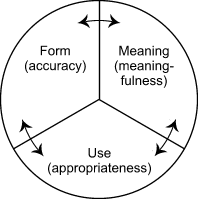
Talking about Coming
Events
Using the Contemplated Aspect of Verbs
Click on a category, and study each grammar point.
![]()
In the contemplated aspect, the -um affix of an -um verb is dropped, and the first syllable of the verb root is repeated, i.e., the first consonant and vowel or first vowel is the root word starts with a verb. The affixes mag- and ma- are not dropped. However, the first syllable of the verb base is reduplicated.
example:
Click on the green button to listen to the
sentence.
![]() Kakain ako.
Kakain ako.
![]() Mag-aaral ako sa
laybrari.
Mag-aaral ako sa
laybrari.
![]() Matutulog ako sa otel.
Matutulog ako sa otel.
![]()
The contemplated aspect of verbs is used to indicate an action that has not started and that is merely anticipated. This aspect is used when you make plans and describe future activities. Oftentimes, a phrase or word that indicates future time is used.
Verb |
Actor (focus) |
Location |
Time Expression |
Kakain |
ako |
|
mamaya |
Mag-aaral |
ako |
sa laybrari |
bukas |
Mamatulog |
ako |
sa otel |
sa Sabado |
example:
Click on the green button to listen to the
sentence.
![]() Kakain ako mamaya.
Kakain ako mamaya.
![]() Mag-aaral ako sa
laybrari bukas.
Mag-aaral ako sa
laybrari bukas.
![]() Matutulog ako sa otel sa
Sabado.
Matutulog ako sa otel sa
Sabado.
![]()
Aspect in Tagalog is indicated by means of verbal inflection that includes adding the affixes ma- and mag- to the root of verbs and reduplication of the first syllables and by merely reduplication without adding an affix for -um verbs.